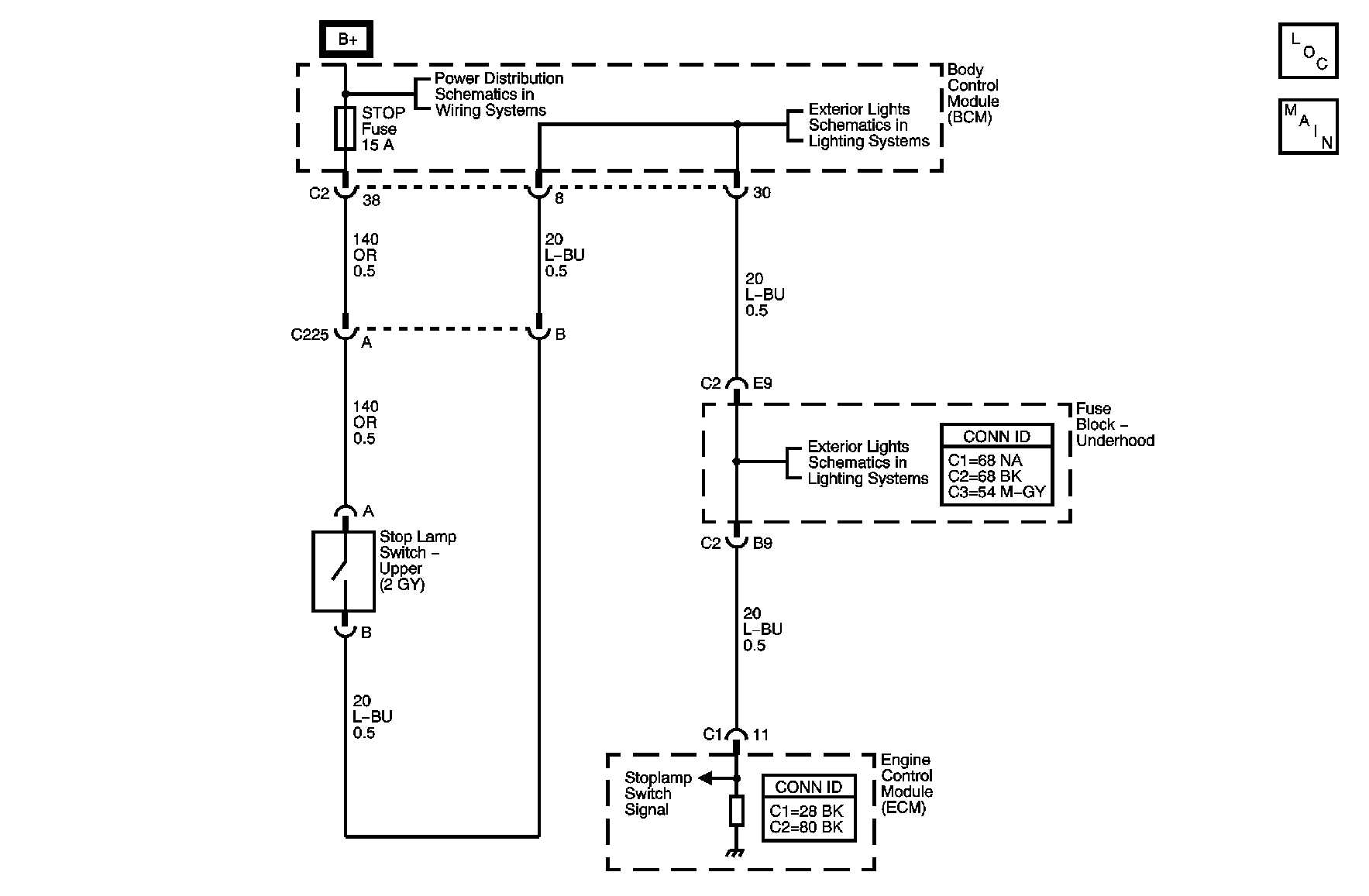DTC P1574 2.2L

Circuit Description
The stop lamp switch is a normally open switch. When the stop lamp switch is closed and the brake pedal is pressed, then the engine control module (ECM) senses ignition voltage on the Stop Lamp Switch Signal circuit. If the ECM senses voltage on the TCC brake switch/cruise control release signal circuit when the torque converter clutch (TCC)/brake switch should be open, this DTC sets.
Conditions for Running the DTC
| • | Vehicle has cycled from 0-60 km/h (0-37 mph) 3 times in 1 ignition cycle. |
| • | Continuous once the previous criteria have been met. |
Conditions for Setting the DTC
The ECM does not detect a voltage state change on the stop lamp switch signal circuit after three stops. A high or low condition will set this code.
Action Taken When the DTC Sets
| • | The ECM stores the DTC information into memory when the diagnostic runs and fails. |
| • | The malfunction indicator lamp (MIL) will not illuminate. |
| • | The ECM records the operating conditions at the time the diagnostic fails. The ECM stores this information in the Failure Records. |
Conditions for Clearing the DTC
| • | A last test failed, or current DTC, clears when the diagnostic runs and does not fail. |
| • | A history DTC will clear after 40 consecutive warm-up cycles, if no failures are reported by this or any other non-emission related diagnostic. |
| • | Use a scan tool in order to clear the DTC. |
Diagnostic Aids
Important:
• Verify that the stop lamp switch is adjusted properly. Refer to
Stop Lamp Switch Adjustment
in Lighting Systems. • If any of the stop lamps are not operating correctly refer to
Stop Lamps Inoperative
in Lighting Systems. • Test drive the vehicle if a switch or circuit condition cannot be located.
An intermittent condition may be duplicated during a test drive. • For an intermittent, refer to
Testing for Intermittent Conditions and Poor Connections
in Wiring Systems.
Test Description
The number below refers to the step number on the diagnostic table.
Step | Action | Yes | No |
|---|---|---|---|
Connector End View Reference: Cruise Control Connector End Views | |||
1 | Did you perform the Diagnostic System Check - Cruise Control? | Go to Step 2 | |
Does the Stop Lamp Switch parameter indicate Applied? | Go to Step 3 | Go to Step 5 | |
3 | Verify that the stop lamp switch is adjusted correctly. Refer to Stop Lamp Switch Adjustment in Lighting Systems. Did you find and correct the problem? | Go to Step 15 | Go to Step 5 |
4 | Inspect the stop lamp switch signal circuits for a short to voltage. Refer to Circuit Testing and Wiring Repairs in Wiring Systems. Did you find and correct the problem? | Go to Step 15 | -- |
5 |
Does the stop lamp Switch parameter indicate Released? | Go to Step 6 | Go to Diagnostic Aids |
6 | Verify that the stop lamp switch is adjusted correctly. Refer to Stop Lamp Switch Adjustment in Lighting Systems. Did you find and correct the problem? | Go to Step 15 | Go to Step 7 |
7 | Do the stop lamps illuminate when the brake pedal is pressed? | Go to Step 11 | Go to Step 8 |
8 | Inspect for poor connections at the harness connector of the stop lamp switch. Refer to Testing for Intermittent Conditions and Poor Connections and Connector Repairs in Wiring Systems. Did you find and correct the condition? | Go to Step 15 | Go to Step 9 |
9 | Inspect the Ignition voltage supply to the stop lamp switch circuits for an open or short to ground. Refer to Circuit Testing and Wiring Repairs in Wiring Systems. Did you find and correct the problem? | Go to Step 15 | Go to Step 10 |
10 | Inspect the stop lamp switch Signal circuits for short to ground. Refer to Circuit Testing and Wiring Repairs in Wiring Systems. Did you find and correct the problem? | Go to Step 15 | Go to Step 12 |
11 | Inspect for poor connections at the harness connector of the ECM. Refer to Testing for Intermittent Conditions and Poor Connections and Connector Repairs in Wiring Systems. Did you find and correct the condition? | Go to Step 15 | Go to Step 13 |
12 | Replace the TCC/brake switch. Refer to Stop Lamp Switch Replacement in Lighting Systems. Did you complete the repair? | Go to Step 15 | -- |
13 | Inspect the stop lamp switch Signal circuit for an open circuit in the branch between the integrated body control module (IBCM) and the ECM. Refer to Circuit Testing and Wiring Repairs in Wiring Systems. Did you find and correct the condition? | Go to Step 15 | Go to Step 14 |
14 |
Important: The replacement ECM must be programmed. Replace the ECM. Refer to Engine Control Module Replacement in Engine Controls. Is the action complete? | Go to Step 15 | -- |
15 |
Does the DTC reset? | Go to Step 2 | System OK |
